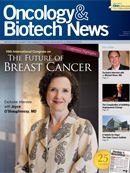The Duke Cancer Institute: A Vehicle for Hope
For more than 75 years, the cancer programs of Duke University Medical Center in Durham, North Carolina, have been at the forefront of research and patient care.

Ongoing construction of the new cancer building at Duke, scheduled to open February 2012.
For more than 75 years, the cancer programs of Duke University Medical Center in Durham, North Carolina, have been at the forefront of research and patient care, with more than 800 researchers, physicians, and clinical staff serving nearly 6000 new patients each year from the United States and abroad. In 1972, Duke’s cancer program was designated as one of the nation’s 8 original comprehensive cancer centers by the National Cancer Institute (NCI), and is today one of only 40 such centers nationwide. Ranked as one of the top cancer hospitals in the United States for nearly 20 years by US News & World Report, Duke attracts the best cancer clinicians and scientists from across the country and around the world, and maintains clinical and research partnerships throughout the United States, as well as in India, China, and Singapore.
Those familiar with Duke’s stellar reputation are well aware of the accolades, honors, and achievements credited to its cancer researchers, clinicians, and academicians, but few milestones have inspired the kind of excitement being generated by the November 2010 formation of the new Duke Cancer Institute (DCI). The DCI brings together clinicians, researchers, and educators from across Duke’s hospital, medical school, and health system under a single administrative umbrella. This, in turn, intimately links patient care, research, and medical training in a unified pursuit. A new cancer center building is scheduled to open in February 2012, and a new leader, Michael B. Kastan, MD, PhD, was named to the Institute’s helm in May.
Already, DCI promises to have a profound impact on both cancer research and patient care. By providing unprecedented and unique opportunities for teamwork between Duke’s scientists and caregivers, the reorganization aims to more quickly translate novel therapies from bench to bedside and to optimize all aspects of patient care. The most important of its goals is to provide patients with a less tangible but equally critical tool in the battle against their cancers: hope. The Preston Robert Tisch Brain Tumor Center and the Duke Prostate Center (DPC) serve as 2 prime examples.
The Center’s 250-plus scientists, physicians, nurses, and other staff have at their disposal the resources of a leading research hub at the cutting edge of translational medicine, providing them with the means to offer patients the latest treatment advances, as well as access to a range of clinical trials, including those examining the efficacy of stem cell therapy and cancer vaccines. Equally important is the Center’s reputation for providing the compassionate support needed by patients and their families living with brain and spinal cancers.
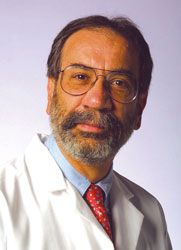
Henry S. Friedman, MD
The Preston Robert Tisch Brain Tumor Center
Using the words “brain cancer” and “hope” in the same sentence may seem counterintuitive, but neuro-oncologist Henry S. Friedman, MD, co-director of the Preston Robert Tisch Brain Tumor Center, does so routinely and unabashedly.
“Everything we do for our patients is doomed to fail unless we’re able to offer them hope,” he said, “and the formation of the new Institute is helping to translate ‘hope’ from nebulous concept to concrete reality.”
Established in 1937 as one of the nation’s first brain tumor research and clinical programs, the Duke program was renamed the Preston Robert Tisch Brain Tumor Center in 2005 in recognition of a $10 million gift from the Tisch family. Today, the Center is one of the world’s leading adult and pediatric neuro-oncology centers, and has received the NCI’s highest rating of “outstanding” for each of the last 10 years.
“The philosophy of hope has always formed the foundation for the care we provide at the Center,” said Friedman, who considers brain and spinal cancers curable until proven otherwise. “This is a guiding principle that necessarily comes from the top down, and is continually nourished and sustained among veteran staff and new hires.” He went on to note that, even for patients living with these most feared of all malignancies, the brain tumor center’s integral role in the DCI fosters hope with an exchange of ideas and research findings that will speed the pace of discovery.
“
Everything we do for our patients is doomed to fail unless we’re able to offer them hope...and the formation of the new Institute is helping to translate ‘hope’ from nebulous concept to concrete reality. ”
—Henry S. Friedman, MD
Friedman cited glioblastoma, the most common malignant brain tumor in adults, as an example. “While most people would tend to use the word ‘hopeless’ when referring to this diagnosis, many patients with glioblastoma don’t necessarily die, and many are living longer than ever before,” he said. This point is borne out by NCI data showing that, compared to 1985, when fewer than 25% of patients lived 5 years with brain cancer, the 5-year survival rate now hovers at 35%, and more patients are surviving 10 and even 15 years past their initial diagnosis. (See seer.cancer.gov.)
“Even those who ultimately succumb to their disease reap the benefits of enhanced quality of life,” Friedman said. “Hope is self-sustaining.” Friedman is, however, careful to differentiate between false hope and the hope given to patients at the Tisch Center. “We’re not talking about some abstract concept based on hand-holding and words of encouragement,” he stressed. “Real hope requires that we deliver substance.”
Duke University Medical Center Cancer Program Timeline
1930
1937
1965
1972
1993
Duke Hospital opens in Durham, NC.
Duke establishes the nation’s first brain tumor program.
Duke establishes the nation’s first physician assistant program.
The Duke cancer program is designated as one of the original 8 comprehensive cancer centers by the National Cancer Institute.
Duke physicians perform the first bone marrow transplant between an unrelated donor and recipient using blood salvaged from an umbilical cord.
Continued below
The 4 Pillars
According to Friedman, “substantive hope” is one of the “4 pillars” that form the foundation for the care provided to the 900 to 1000 newly-diagnosed patients seen each year at the Tisch Center. The other 3 core missions are basic research, clinical research, and exemplary patient care.
While the evaluation of a variety of therapeutic approaches is nothing new in the field of neuro-oncology, the care teams at the Tisch Center take this approach a step further by assessing the feasibility of multiple treatment strategies attempted not in sequence but all at once. “Rather than trying one treatment and then another when the first fails, we look at a comprehensive approach to treatment for each patient that may involve the use of multiple therapies from the onset,” he explained.
Such an approach might involve approved therapies, along with those under investigation through clinical trials, including vaccines and targeted therapies involving monoclonal antibodies and anti-angiogenesis agents. The Center’s researchers also are involved in comprehensive genetic analyses aimed at identifying tumor aberrations for targeting by these novel agents. “What the DCI does is foster a venue for the free flow of information among our scientists and clinicians,” Friedman said. “There’s little doubt that our patients will be the primary beneficiaries.”
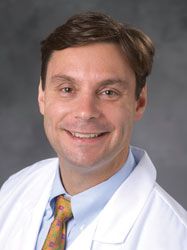
Daniel J. George, MD
The Duke Prostate Center
Also receiving a new infusion of hope by virtue of DCI’s reorganization are the patients of Duke’s genitourinary cancer program, which has long been a leader among the specialties of Duke’s cancer program.
Each year, Duke clinicians treat 700 to 800 newly diagnosed prostate cancer patients from around the world, and the number of those seeking treatment and/or second opinions at the DPC continues to grow. One favorable “side effect” of this growth is the recent influx of more than a dozen top medical oncologists, urologists, and radiation oncologists into the Duke program.
From the beginning, patients have had the opportunity to interact with a variety of specialists at the prostate cancer center, including urologists, medical oncologists, radiation oncologists, and support staff. But with the center’s scheduled move into the new clinical building in February, patients will have access to all prostate specialists under one roof in a facility that also will house many of the Center’s scientists.
Urologist and medical oncologist Daniel J. George, MD, has been the director of the section of genitourinary medical oncology at Duke University Medical Center since 2003, and was recently appointed Duke’s medical director of cancer clinical research.
“Our genitourinary cancer program serves as an excellent example of how and why the DCI will set Duke apart from other cancer centers,” said George. “As successful as our cancer programs have been, the separation between research and clinical care has been somewhat limiting, and the new Institute is providing the means and venue for true continuity with respect to both research and patient care.”
“
As successful as our cancer programs have been, the separation between research and clinical care has been somewhat limiting, and the new Institute is providing the means and venue for true continuity with respect to both research and patient care. ”
—Daniel J. George, MD
In what he described as a paradigm shift, George explained that the historically department-based faculty has now become program-based, with all resources pooled under the DCI umbrella. Also unique is the geographic proximity of the undergraduate campus to the medical center, facilitating collaboration between medical oncology, radiation oncology, pharmacology, and those from departments such as chemical engineering.
“It’s an exciting time for genitourinary cancer researchers,” said George, whose own research includes trials of drugs that inhibit blood flow to tumors and whose areas of interest include the study of blood flow in renal cell carcinoma and growth factors as prognostic markers and molecular targets in prostate cancer.
“We’re now making very real strides in our understanding of the biology of these cancers, which, in turn, allows us to make some very meaningful progress,” he said. George cited end-stage metastatic prostate cancer as a prime example, noting that, even in this late stage, the disease still appears to be testosteronedependent. “This relatively new understanding has moved the field toward targeted therapies even in castrate-resistant disease,” he explained, noting that ongoing research in areas such as upregulation of androgen and the use of copperdependent agents to create conditional lethality is especially exciting.
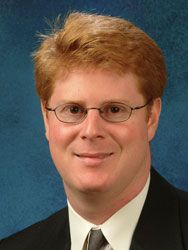
Stephen J. Freedland, MD
Echoing George’s enthusiasm is Stephen J. Freedland, MD, Duke’s vice chief of urology research and associate director of genitourinary cancer clinical research. Freedland views the reorganization provided by the new Institute as a natural next step in the evolution of cancer care and research.
“The reorganization removes some significant barriers and allows us to take full advantage of our colleagues’ areas of strength and expertise,” he said. Freedland noted, for example, that clinical trials have historically tended to be a strength of medical oncologists, while urologists tended to excel at creating databases. The shared expertise made possible by the DCI will give Freedland access to the best of both worlds in his planned clinical trials to examine the effects of diet and lifestyle modifications on the progression of prostate cancer. He noted that it also will prove beneficial in his ongoing trial of the use of hormonal therapy in prostate cancer and a low-sugar diet for resultant diabetes.
Some clinics have already been integrated, and Freedland noted that clinicians have begun to meet monthly to discuss patient care. “Everyone will have an equal voice and an equal stake in patient outcomes,” he said, adding that even physician compensation will be determined by group productivity.
“We’re all in this together,” he said. “While many in the profession tend to give lip service to the terms ‘teamwork’ and ‘multidisciplinary,’ it’s hard to imagine patient care, research, and even compensation being more intimately tied than here at Duke.”
“
We’re all in this together. While many in the profession tend to give lip service to the terms ‘teamwork’ and ‘multidisciplinary,’ it’s hard to imagine patient care, research, and even compensation being more intimately tied than here at Duke. ”
—Stephen J. Freedland, MD
George agreed, citing the DCI as an example of the commitment to “break down barriers, pool resources, and live and die by the program’s success.”
George said that commitment is truly put to the test when patients are feeling especially desperate.
“It’s especially inspiring to me when I see patients come from elsewhere with exhausted options and we’re able to give those patients and their families a very real and concrete sense of hope,” George said.
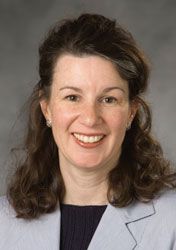
With the integration of all facets of care into one physical and administrative setting, nurses will be working with new clinicians in new settings, and all will need to adjust to the realities of sharing and managing space and resources. —Tracy K. Gosselin, RN
Nursing as the “Glue”
The rapid emergence of new therapies for both prostate and brain cancers has placed a renewed focus on the need for exemplary patient education and advocacy. “If we don’t adequately explain the potential benefits and side effects of these new treatments, we run the risk of patients becoming noncompliant or simply giving up on treatment,” said George. “And for those living with cancer as a chronic condition, patient education becomes a life-long necessity,” he added, acknowledging that nurses are often better than physicians at helping patients cope with the nuts and bolts of living with their cancer and the effects of therapy.
Tracy K. Gosselin, RN, Duke University Medical Center’s associate chief nursing officer, noted that the new structure brought about by the DCI has shined a light on the need to examine the roles of nursing in a changing environment. “Many would describe nurses as the glue that ties together all the aspects of care for our patients,” she said. Not surprisingly, education, advocacy, and symptom management are areas of critical importance. “To us, creating a weekly calendar of scheduled appointments or helping to translate the jargon of a consent form may seem routine, but to patients such things can actually make the difference between quitting and remaining on treatment,” Gosselin said.
Duke University Medical Center Cancer Program Timeline Continued
2003
2005
2010
2011
2012
A national clinical trial led by Duke researchers is the first to show that a drug could shrink tumors by choking off its blood supply, leading to new weapons against brain tumors and other malignancies.
Duke’s brain tumor program is renamed the Preston Robert Tisch Brain Tumor Center.
The Duke Cancer Institute (DCI) is formed to unite patient care, research, and learning under a shared mission.
Michael B. Kastan, MD, PhD, formerly of St. Jude Children’s Research Hospital, is named the new executive director of the DCI.
A new 7-story, $220-million cancer building is scheduled to open at the heart of the hospital campus, adding 123 clinical rooms, 73 infusion stations, radiation oncology, and other services for outpatient care.
Challenges and Promise
With the opening of the new outpatient facility in 2012, both care and resources will be realigned, and Gosselin noted that the nursing care delivery model has been undergoing transformation for the past 18 months. “In our disease-based clinics, nurses have historically worked with specific physicians to treat specific cancers. With the integration of all facets of care into one physical and administrative setting, nurses will be working with new clinicians in new settings, and all will need to adjust to the realities of sharing and managing space and resources.”
Such a change, said Gosselin, requires trust, and building trust takes time. “As we transition into the new building, nurses will be educated and reeducated, and every effort will be made to ensure that all feel part of the team.”
Already, a retreat for nurses working in the DPC provided an opportunity to reexamine intake, clinic time, phone triage, and other issues that surfaced. Additionally, efforts are being made to align not just nurses and physicians but also social workers, dieticians, family and marital counselors, and other support staff in what amounts to a new configuration of care.
Also on Gosselin’s short list of challenges is the nursing shortage and, in particular, finding ways to entice those with decades of front-line oncology experience to remain on staff or return post-retirement in a part-time or shift-work capacity. To this end, Gosselin stressed the importance of providing opportunities for continuing education, career trajectory, and other sources of professional satisfaction.
It is, said Gosselin, one of the great satisfactions of nursing to work with patients from diagnosis, through treatment, and on to long-term survivorship. Inherent challenges notwithstanding, she noted that the DCI promises to provide both the means and the opportunity for the collaborations that make such survivorship a reality.
Laura Bruck is a Cleveland, Ohio-based freelance writer and editor who has specialized in healthcare reporting since 1987.
